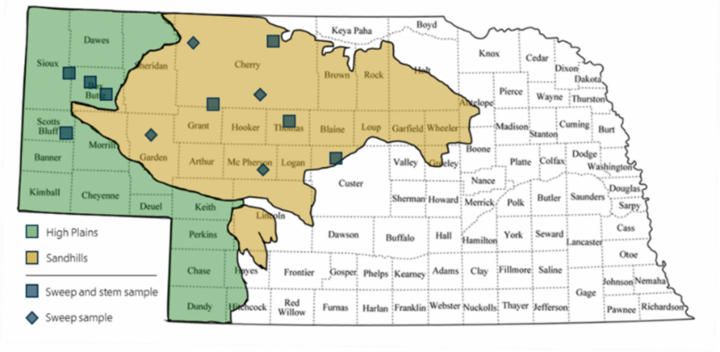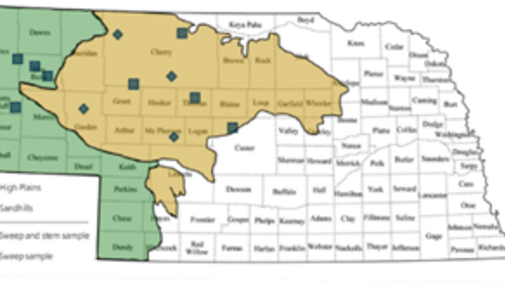Sawfly Landscape Ecology Project

The sawfly survey was discontinued in 2017; however, these data are being used strategically for grassland and on-farm evaluation of sawfly-parasitoid relationships (Figure 1).
We are conducting a survey and landscape analysis to better understand the ecology of both the wheat stem sawfly and its parasitoid in Nebraska. The parasitoid is currently the most effective control method for the wheat stem sawfly in Nebraska. Because the wheat stem sawfly is native to North America, it infests many grasses (not just wheat). Because parasitoid-sawfly relationships may have had more time to co-evolve in a native setting (e.g., the Nebraska Sandhills), our survey is conducting survey transects that span both wheatland and grassland regions. In both regions, we are surveying grassland species from borrow pits to rangeland to seek out both sawflies and sawfly parasitoids. We are collecting sweep net samples and stem samples through the survey range. Through this work we hope to better understand the role of grasslands in sustaining or regulating sawfly populations. However, we are particularly focused on identifying plants and habitats that may encourage greater conservation of sawfly parasitoids and biological control mechanisms.
Synopsis of Results to Date
- Some of the most dominant grassland plants in our survey are crested wheatgrass, intermediate wheatgrass, needle and thread, sand dropseed, and smooth brome.
- All dominant grass species had some level of infestation of stem sawfly (Table 1). Smooth brome had the highest infestation level (average of 43.4%).
- All dominant grass species had some level of sawfly parasitism. The highest proportion of sawfly parasitism was found in intermediate wheatgrass (about 19%).
- Further analysis is underway to relate findings in grasslands to wheatland.
| Dominant Grasses | % sawfly-infested tillers | % parasitoids in tillers |
|---|---|---|
| Crested Wheatgrass | 9.5 | 0.6 |
| Intermediate Wheatgrass | 20.3 | 3.9 |
| Needle and Thread | 0.4 | 0 |
| Sand Dropseed | 11.5 | 1.5 |
| Smooth Brome | 43.4 | 5.1 |

